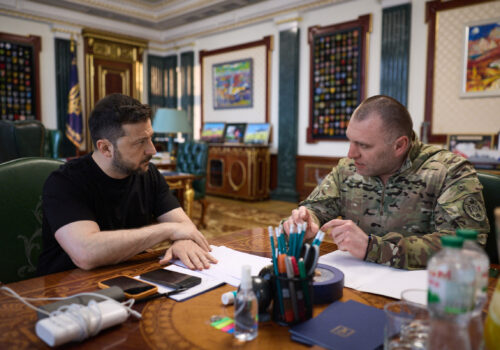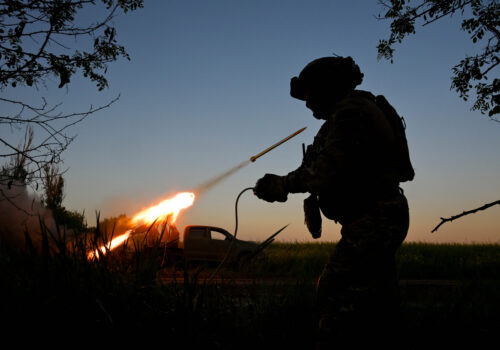Ukraine just gave us a glimpse into the future of European defense
Ukraine’s audacious attack on Russian strategic bombers this past weekend, damaging more than a third of Russian President Vladimir Putin’s capabilities, provided an encouraging glimpse into what should be the future of European and transatlantic defense.
Imagine a world in which Ukraine, working alongside European and North American partners, so convincingly wields advanced technological and defense capabilities that Putin stops his murderous war and agrees to a sustainable peace. That also would send an unmistakable message of transatlantic common cause to Russia’s partners: China, North Korea, and Iran.
However, that outcome can only be achieved if the European Union (EU), after decades of neglect, turns Ukrainian inspiration and a flood of new defense spending announcements into real capabilities and technological innovation. It will also require that the Trump administration unambiguously back its European allies at the June 24-25 NATO Summit in The Hague as the Alliance makes new spending and defense production commitments.
‘A fusion of World War I and World War III’
The good news is that most NATO countries appear ready to agree at the summit to increase their defense spending to 3.5 percent of gross domestic product by 2035, along with an additional 1.5 percent for defense- and security-related infrastructure. For its part, the EU has already approved 800 billion euros in new defense spending across the bloc over the next four years.
The bad news comes in three categories: production, policies, and politics. First, even a great deal more money won’t necessarily result in the production, innovation, and capabilities required to deter Russia. Second, policies and regulations on both sides of the Atlantic provide impediments to effective defense industrial cooperation. Third, political strains and distrust have increased across the Atlantic over US President Donald Trump’s trade wars and his administration’s decision to withhold arms and intelligence from Ukraine for about a week in March.
Trump’s phone call with Putin yesterday, after which he said without comment that the Russian leader felt a strong need to respond to Ukraine’s strikes inside Russia, didn’t help. Ukraine and its European partners would have preferred clear recognition that Putin started the war, has the power to end it, and should do so now.
Even with all of that said, Europe’s most immediate and important task is to demonstrate that it can provide for its own security, given the Trump administration’s understandable reluctance to do more for US allies than they are willing to do for themselves.
“Ukraine has shown that modern warfare is a fusion of World War I and World War III—combining trench warfare with cutting-edge technologies,” write Ann Mettler and Mark Boris Andrijanič in a must-read piece in Euractiv. “Unless Europe learns to master both, its security, sovereignty, and very survival will be at stake.”
Few know the stakes better than Mettler, a former director-general at the European Commission, and Andrijanič, a former Slovenian minister for digital transformation and a current Atlantic Council Europe Center senior fellow. They outline a compelling course of action to reverse EU security weaknesses.
“As Russia’s aggression edges closer to EU borders and the transatlantic alliance weakens,” they write, “Europe stands at an inflection point.” European defense budgets are finally increasing, they note, “but if past performance is any indication of future results, there is cause for concern.”
For example, despite hundreds of billions of euros of investments into digital and green agendas, the EU remains reliant on American software and Chinese hardware, from solar panels to batteries. “This reveals a harsh truth,” they write, “spending alone doesn’t guarantee innovation. And in defence, failure won’t just be costly—it could be fatal.”
‘Something we should have done years ago’
I came away from a recent Atlantic Council delegation trip to Brussels, where we met with top NATO and EU defense planners, with new hope for European security but also growing concern about transatlantic division in the face of persistent Russian threats.
It’s clear that Europe has been shocked into action by two leaders: Putin and Trump. The Russian president’s full-scale invasion of Ukraine in February 2022 was a wake-up call for a complacent Europe. Yet it was only Trump’s return to the presidency this year that injected Europe with a greater sense of urgency.
It’s telling that Mettler and Andrijanič don’t include a transatlantic dimension in their proposals in Euractiv. I asked Andrijanič about this omission, and he said, “Unless Europe gets serious about defense, we can’t be a credible partner for the United States.” He added, “Suddenly we are doing something we should have done years ago. Europe is now laser-focused on developing as many critical capabilities as possible—and doing it fast.”
In their Euractiv article, Mettler and Andrijanič list as their priority the creation of a common market for defense, stretching from the EU to partners such as the United Kingdom, Norway, Switzerland, and, in particular, Ukraine. For the moment, the only European-headquartered company among the global top ten defense firms is the United Kingdom’s BAE Systems.
The authors also call for new EU regulatory guidance that would remove the stigma against defense and dual-use investments to unlock private and institutional capital. They also want to shake up Europe’s “sluggish defense procurement rules and procedures.”
To achieve greater innovation, the authors want to create a European ecosystem of “established industry players, startups and scaleups, investors, governments, and research institutions.” One intriguing proposal is for a dedicated collaboration platform to create a “wall of drones” along Europe’s eastern flank, so that Ukraine’s weekend success isn’t a one-off but is underpinned by “a coordinated deployment of autonomous drone swarms for surveillance and defense.”
The authors seize upon two successful US models to accelerate this European effort. One would be the creation of a European DARPA, modeled on the Pentagon’s Defense Advanced Research Projects Agency, which has focused on developing emerging technologies for national security. They would do that through transforming the existing European Defence Fund into “a better-resourced, more agile, and mission-driven institution.”
A second idea would be to use the US Defense Innovation Board, first chaired by former Google CEO Eric Schmidt, as a model for a European Defence Innovation Council. This high-level, independent group would provide strategic advice to the EU and member states on defense-related tech.
Write the authors, “The good news for Europe is that the world’s leading defence innovator is already among us, and on our side—Ukraine. Despite intense wartime pressures, the country has emerged as a frontrunner in drone technology, cyber warfare, and the integration of artificial intelligence on the battlefield. In contrast to Europe’s slow and costly model of incremental innovation, Ukraine excels in frugal innovation to rapidly deliver scalable, cost-effective, and highly impactful solutions.”
Two awful words
One way or the other, the upcoming NATO Summit will be one of historic importance. What’s positive is an Alliance-wide commitment, after pressure from Trump, for greater spending aimed at producing cutting-edge capabilities. What’s negative is insufficient recognition that transatlantic common cause on Ukraine and beyond is more crucial than ever.
Speaking to the NATO Parliamentary Assembly in Dayton, Ohio, last week, NATO Secretary General Mark Rutte put it this way: “Russia has teamed up with China, North Korea, and Iran. They are expanding their militaries and their capabilities. They are preparing for long-term confrontation.”
Quoting Winston Churchill from 1936, Rutte asked, “Will there be time to put our defenses in order? . . . Will there be time to make these necessary efforts, or will the awful words ‘too late’ be recorded?”
Frederick Kempe is president and chief executive officer of the Atlantic Council. You can follow him on X: @FredKempe.
This edition is part of Frederick Kempe’s Inflection Points newsletter, a column of dispatches from a world in transition. To receive this newsletter throughout the week, sign up here.
Further reading
Tue, Jun 3, 2025
Putin’s punitive peace terms are a call for Ukraine’s complete capitulation
UkraineAlert By Peter Dickinson
Vladimir Putin's punitive peace terms for Ukraine would leave the country at the mercy of the Kremlin and confirm his unwavering determination to erase Ukrainian statehood, writes Peter Dickinson.
Sun, Jun 1, 2025
Dispatch from Kyiv: Ukraine’s daring drone attack gives Trump leverage against Putin
New Atlanticist By John E. Herbst
Ukraine’s June 1 drone strikes against five bases across Russia underscored its ingenuity and may help shape the negotiations to come.
Thu, May 29, 2025
Welcome to the long war: Why a Ukraine deal was never realistic
New Atlanticist By Brian Whitmore
There is no deal to be had with Russia on Ukraine—there never has been, and there never will be.
Image: A satellite image shows destroyed aircrafts in the aftermath of a drone strike at the Olenya air base, Murmansk region, Russia, June 4, 2025, Maxar Technologies/Handout via REUTERS



